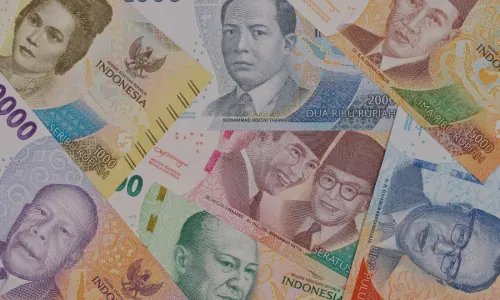10 interesting facts about Euros
The euro stands as one of the world's most influential currencies, symbolizing the economic integration and stability of the Eurozone. Introduced on January 1, 1999, and adopted as physical currency three years later, the euro has since become a cornerstone of international finance. Today, it is the second most traded currency globally, with approximately 33% of foreign exchange reserves held in euros (source: IMF). In the current year, the collective GDP of the 27 member states constituting the European Union totaled around 15.8 trillion euros (source: Statista). As a key player in global financial markets, the euro's value and stability profoundly impact economies worldwide, making it a pivotal currency in the realm of international trade and finance.
1. Introduction of the Euro
The euro, introduced on January 1, 1999, marked a significant milestone in European economic integration. Initially adopted by 11 countries, the euro aimed to strengthen economic ties and promote stability across Europe. These founding member states included:
At its introduction, the euro's value was set at 1 euro to 1.1686 US dollars. This event not only simplified currency transactions across borders but also laid the groundwork for the expansion of the Eurozone in subsequent years, demonstrating Europe's commitment to unified economic growth and cooperation.
2. Euro vs. USD Exchange Rate Trends
The exchange rate between the euro (EUR) and the US dollar (USD) has been subject to significant fluctuations since the euro's introduction. Initially launched at a rate of 1 euro to 1.1686 US dollars in 1999, the euro experienced notable volatility in its early years. For instance, by October 2000, the euro had depreciated to approximately 0.823 US dollars before stabilizing in subsequent years. Over the past two decades, the exchange rate has seen periods of strength and weakness, influenced by various economic factors and geopolitical events.
As of the latest update, the current exchange rate stands at approximately 1 euro to 1.12 US dollars (source: XE.com). This rate reflects ongoing market dynamics and the respective monetary policies of the European Central Bank (ECB) and the Federal Reserve. The euro's exchange rate with the US dollar is closely monitored by investors, businesses, and policymakers worldwide due to its implications for international trade, tourism, and financial markets.
The historical and current exchange rate data highlight the dynamic nature of the EUR/USD currency pair, illustrating its role as one of the most widely traded and influential currency pairs in the global forex market.
3. Euro Banknotes and Coins
The euro banknotes and coins, introduced in 2002, are recognized for their distinct design and range of denominations. The banknotes come in seven denominations: €5, €10, €20, €50, €100, €200, and €500, each featuring architectural styles from different periods in European history. Meanwhile, the coins have a common European side and a national side unique to each issuing country. They are available in eight denominations:
- 1cent
- 2 cents
- 5 cents
- 10 cents
- 20 cents
- 50 cents
- €1
- €2
As of the latest data, there are approximately 27.6 billion euro banknotes in circulation, with a total value of about €1.5 trillion (source: European Central Bank). Additionally, the number of euro coins in circulation exceeds 140 billion, highlighting the widespread use and acceptance of the euro across member states (source: European Commission). These statistics underscore the euro's pivotal role in daily transactions and its significance in the broader economic landscape of Europe.
4. Economic impact of the Euro
The introduction of the euro has significantly impacted the economies of its member countries, fostering economic integration and stability. Since its adoption, the euro has facilitated easier and more efficient cross-border trade, reducing currency exchange costs and eliminating exchange rate uncertainties. This economic integration has contributed to GDP growth rates within the Eurozone, which collectively saw an average annual growth rate of 1.2% from 1999 to 2019, compared to 0.8% in the decade before the euro's introduction (source: Eurostat). Additionally, inflation rates across the Eurozone have generally stabilized, with the average inflation rate hovering around 1.7% from 1999 to 2023, compared to higher and more volatile rates before the euro era (source: European Central Bank).
Trade statistics also highlight the euro's impact. Intra-Eurozone trade has increased significantly, with the value of goods traded between member countries growing from approximately €1.5 trillion in 1999 to over €3.1 trillion in 2022 (source: Eurostat). This growth underscores the euro's role in enhancing economic cooperation and increasing the competitiveness of Eurozone economies on the global stage. Overall, the euro has been instrumental in promoting economic stability and growth among its member states, contributing to a more unified and resilient European economy.
5. Eurozone Countries
The Eurozone originally comprised 11 countries when the euro was introduced in 1999. Since then, the Eurozone has expanded to include 19 countries, with additional nations adopting the euro over time. These countries are:
- Belgium
- Germany
- Ireland
- Spain
- France
- Italy
- Luxembourg
- Netherlands
- Austria
- Portugal
- Finland
- Greece (joined in 2001)
- Slovenia (2007)
- Cyprus (2008)
- Malta (2008)
- Slovakia (2009)
- Estonia (2011)
- Latvia (2014)
- Lithuania (2015)
The Eurozone collectively represents a significant portion of the European Union's population and economic output. As of 2023, the Eurozone's population stands at approximately 342 million people (source: Eurostat). The combined GDP of the Eurozone countries is around €11.2 trillion, making it one of the largest economic regions globally (source: European Central Bank). This integration has strengthened economic ties among member states, enhancing economic stability and growth throughout the region.
6. The Euro and International Trade
The euro plays a crucial role in global trade, serving as the second most commonly used currency for international transactions after the US dollar. Approximately 30% of global trade is conducted in euros, highlighting its importance in the global economy (source: European Central Bank). The euro is particularly significant in trade with the European Union's major partners, including the United States, China, and the United Kingdom. In 2022, the EU's exports to these countries were valued at €2.3 trillion, with imports totaling around €2.1 trillion (source: Eurostat). The widespread use of the euro in international trade not only facilitates smoother transactions but also reinforces the euro's position as a stable and reliable currency in the global market. This extensive use underscores the euro's impact on enhancing economic relations and promoting trade efficiency worldwide.
7. Euro as a reserve currency
The euro has solidified its status as a global reserve currency, reflecting its stability and trustworthiness. As of 2023, the euro accounts for approximately 20% of global foreign exchange reserves, making it the second most held reserve currency after the US dollar, which holds around 58% (source: International Monetary Fund). This substantial share underscores the confidence that central banks and financial institutions around the world have in the euro. The euro's role as a reserve currency enhances its liquidity and demand in international markets, contributing to its strength and stability. The widespread adoption of the euro in global reserves highlights its importance in maintaining economic balance and fostering international financial cooperation.
8. Security Features of Euro Banknotes
Euro banknotes are equipped with advanced security features designed to prevent counterfeiting, ensuring their integrity and reliability. These features include holograms, watermarks, raised printing, security threads, and ultraviolet ink, among others. The introduction of the second series of euro banknotes, known as the Europa series, has further enhanced these security measures with additional elements such as portrait windows and improved holograms.
The effectiveness of these security features is evident in counterfeiting statistics. In the years following the introduction of the Europa series in 2013, the number of counterfeit euro banknotes detected annually decreased significantly. In 2013, approximately 670,000 counterfeit notes were removed from circulation, whereas by 2021, this number had dropped to about 368,000 (source: European Central Bank). This substantial reduction in counterfeiting incidents highlights the success of the enhanced security features in protecting the euro against forgery, maintaining public trust in the currency's authenticity.
9. Eurozone Debt Crisis
The Eurozone debt crisis, which began in 2009, had profound implications for several member countries, exposing vulnerabilities in the region's financial system. Countries like Greece, Ireland, Portugal, Spain, and Cyprus were hit hardest, with Greece's debt-to-GDP ratio peaking at over 180% in 2011 (source: Eurostat). In response to the crisis, substantial bailout packages were provided by the European Union and the International Monetary Fund, totaling around €289 billion for Greece alone (source: European Stability Mechanism).
The crisis led to severe austerity measures, economic contractions, and high unemployment rates in the affected countries. However, recovery efforts have shown mixed results. By 2023, Greece's debt-to-GDP ratio had decreased to approximately 171%, and the country experienced positive GDP growth rates averaging around 1.5% annually since 2017 (source: Eurostat). Similarly, Ireland saw a robust economic recovery with an average annual GDP growth rate of about 5.9% from 2013 to 2022 (source: World Bank).
Despite the challenges, the crisis led to significant reforms in the Eurozone's financial governance, including the establishment of the European Stability Mechanism (ESM) and stricter fiscal oversight, aiming to prevent similar crises in the future and bolster the region's economic stability.
10. Future of the Euros
The future of the euro appears promising, with experts predicting continued stability and potential expansion. According to projections by the European Commission, additional countries, including Bulgaria and Croatia, are expected to adopt the euro in the coming years, further enlarging the Eurozone. Bulgaria aims to join the Eurozone by 2025, while Croatia adopted the euro on January 1, 2023, as the 20th member (source: European Central Bank).
Regarding the euro's exchange rate, analysts from various financial institutions, including the International Monetary Fund and Goldman Sachs, forecast that the euro will maintain its strength against the US dollar. Predictions for 2024 suggest that the euro could appreciate slightly, with exchange rates potentially reaching 1.15 to 1.18 USD per euro, depending on economic conditions and monetary policies (source: Reuters).
Experts also anticipate that the euro will continue to play a vital role in global finance, with its share of international reserves possibly increasing as more countries diversify away from the US dollar. As the Eurozone economies strengthen and integrate further, the euro is poised to enhance its status as a key global currency, supporting economic growth and financial stability in Europe and beyond.
Table of contents
- Introduction of the Euro
- Euro vs. USD Exchange Rate Trends
- Euro Banknotes and Coins
- Economic impact of the Euro
- Eurozone Countries
- The Euro and International Trade
- Euro as a reserve currency
- Security Features of Euro Banknotes
- Eurozone Debt Crisis
- Future of the Euros
Need to exchange AUD to Euros?
Order your currency online and enjoy 0% commission and the best exchange rates online.
Read about other currencies
10 interesting facts about GBP
In this post, we reveal ten amazing facts about the GBP that will help you understand its importance on the world stage and how it affects the choices you make about investments and travel.
10 interesting facts about the IDR
Discover 10 intriguing facts about the Indonesian Rupiah, backed by comprehensive statistics and data. offering a detailed look into this essential aspect of Indonesia's financial system.
10 interesting facts about NZD
The New Zealand Dollar, also known as "Kiwi", is a vital component of the world economy. In this post, discover 10 interesting facts about NZD's history, usage and impact on New Zealand society and economy.


